A drystone wall does not use cement or mortar to hold the stones together . The stones are used just as they are found (or quarried) and not dressed (cut to size). Drystone walls created boundaries showing landownership and were also a means of controlling livestock. Slab stiles were built to serve as crossing places where walls intersected with paths. On sloping ground the walls often followed the contours, acting as retaining walls and allowing terraces to be formed. For example south of Redbrook, but now lost in the woods, terraces are evidence that the land in this area was once open land.
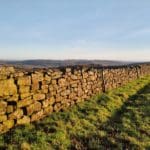

Drystone wall at Ninewells, Catbrook
The heyday for drystone walling was between 1750 and 1850 when the Enclosure Acts saw communal land replaced by a system of private land management. Local Tithe maps of the 1840s show the field pattern already well established and walls visible today can still be traced using these maps. Most walls in the Wye Valley were probably built by the original occupiers of the land. Estate workers and farmworkers also built walls, often when other work was scarce to keep them occupied. Gangs of itinerant Irish ‘Wallers’ who travelled the country may also have been involved. Areas such as the Hudnalls were transformed by squatters moving onto the common, clearing woodland and laying claim to parcels of land.
Some of the walls may be much older than those associated with the Enclosure Acts. Local legend has it that the drystone walls around Catbrook were built by Napoleonic prisoners of war in the early 19th century. Intriguingly, nearby on the highest point overlooking the fields, are the ruins of a circular stone tower. Could this have been used to watch over prisoners constructing the walls? Also nearby is a stone stile on which you may just be able to make out a fox’s face, scratched into the stone. Local people recall writing underneath, possibly in French, but nolonger visible. More than 200,000 French Prisoners of War were held between 1793 and 1814 and maybe some of these Frenchmen left their mark on the landscape here. Going back even further, the walls near Ninewells Farm at Catbrook are said to be associated with the monastic activities of Tintern Abbey.
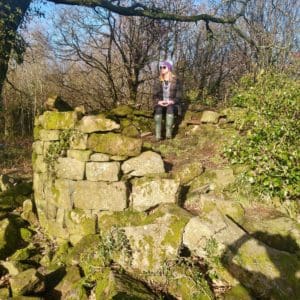

Stone tower overlooking fields near Catbrook
The two sloping faces of the wall are called the ‘batter’. The middle of the wall (called the ‘hearting’) is filled with small stones and the row of large vertical stones along the top is called the ‘cope’. Typically the first course of stones is made of the largest stones, although in the Wye Valley this is not always the case making the walls top heavy. The Wye Valley walls don’t have copestones, which traditionally helped to tie the two sides of the walls together and deter sheep from jumping over. It may be that the sheer size and width of the Wye Valley walls make copestones unnecessary. The Wye Valley walls have little or no slope to the batter, having nearly vertical faces. The large size of the stones and the frequency of their use within a small area is not seen elsewhere in Britain (apart from North Wales).
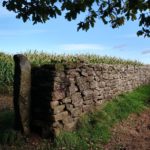

Drystone wall at Catbrook
The geology of the Wye Valley influences the appearance of the drystone walls in the area. There are three main rock types used here – Old Red Sandstone, Quartz Conglomerate and Limestone. On the English side of the river sandstone walls are found toward the valley floor, but the top of the valley sides and especially in the south the predominant stone is limestone. Despite its name Old Red Sandstone occurs in a variety of colours, most frequently on the Welsh side of the Wye. Quartz conglomerate is less often used. It is a sandstone containing quartz pebbles which is locally called ‘pudding stone’ or ‘jack stones’.
Today these walls provide a haven for wildlife and are refuges for amphibians and reptiles. Wagtails and wheatears also use the walls to nest in. Many specialised plants such as pennywort, lichens and mosses can be found on drystone walls.
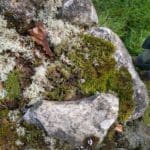

Specalised plants such as pennywort, lichen and mosses thrive on stone walls.
Many drystone walls have been lost elsewhere in the UK, especially through field expansion. But in the AONB the pattern of fragmented land ownership and small holdings, which are not viable for large scale farming, has meant the traditional walls have survived, conserving the characteristic landscape of small fields of (mostly) unimproved semi-natural grassland. The walls are threatened now due to the cost of repairing drystone walls compared to replacing them with fencing. A decline in the number of skilled drystone wallers is also a factor. Built correctly a drystone wall can remain standing for centuries.
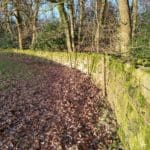

Distinctive stone walls surrounding Ninewells Wood